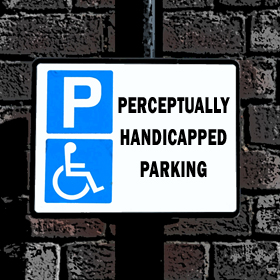Wine Appreciation. It’s All About Paying Attention.
Chapter Four, Part One.
 It’s an uncomfortable feeling. You’re in a fine wine store and when you look down at the shelf talker you get the uneasy feeling that the shelf talker is actually looking down at you. How can something as insignificant as a four-inch wine review make you feel like you should be parked in the perceptually handicapped space?
It’s an uncomfortable feeling. You’re in a fine wine store and when you look down at the shelf talker you get the uneasy feeling that the shelf talker is actually looking down at you. How can something as insignificant as a four-inch wine review make you feel like you should be parked in the perceptually handicapped space?
If you feel you’re not capable of perceiving the complex aromas and flavors found in wine, it’s likely that you simply haven’t been paying enough attention. It’s time for your palate to wake up and smell the rosés. Believe me, with some conscious effort and practice, you too can analyze and describe wine like a pro and then you’ll annoy all your friends, not just the ones who stick around to drink your classified Bordeaux.
There are those who believe that wine criticism is the domain of the piously pretentious, best left to the chosen few with the innate gifts required for the scrutiny of all things vitus. Wine appreciation shouldn’t be an exclusive club, cult or cabal. It’s not a scientific, romantic or religious pursuit. Wine appreciation is more akin to art or music appreciation. You don’t have to be a Julliard alumnus to be moved by the classic masters, Mozart, Coltrane and Snoop Doggy Dogg and you don’t have to be a certified sommelier to appreciate Grand Cru Burgundy, you just have to be rich.
Wine publications like The Wine Spectator and The Wine Advocate introduced us to the idea that maybe we too can describe wine by making comparisons to aromas and flavors that are familiar to us. Analyzing and describing wine starts by paying attention and making associations. With a little persistence (and a lot of wine) these associations will become clearer to you. Some days they leap out of the glass, and other days they’re as elusive as a 99 point score on a $9.99 bottle of wine.
The Memory Bank ATM
We all have a database filled with memories of our personal olfactory and gustatory experiences. You have one too. It’s standard equipment. The trick is to tap into these sense memories and make the proper associations with them when you analyze wine. Although you may not realize it, you’ve spent your lifetime stocking this database with your personal perceptions of how things smell and taste.
When you were a child, you may have woken one morning to the distinctive smell of fresh road tar being applied to your street and made a deposit under the heading ‘road tar.’ The first time you tasted a strawberry you filed the perception away in the database and reinforced the memory with every strawberry that followed. This memory bank contains your wine vocabulary and is your greatest resource in your new hobby as a wine enthusiast. It’s like having built-in Cliff Notes, or as they’re known in the trade, Whiff Notes.
When you taste wine ask yourself, “What does this wine remind me of.” Don’t be one of those people who take a sip of wine and think, “This wine tastes like wine… period,” and then ignore the multifaceted beverage in their glass. You must hone your perception skills by paying attention to the flavors swirling over your palate or you won’t be able to take the next all-important step of connecting them with the sense memories in your database. In time these associations will become second nature, but until then you must focus on the aromas and flavors for minutes, not seconds.
Your newfound appreciation for wine will compel you to reinvigorate your olfactory database. Start renewing your acquaintances with your sense memories by paying attention to everyday aromas. Create and file new sense memories in your database by going out of your way to experience new aromas and flavors. When I first read that Cabernet Sauvignon is often redolent of cassis, I purchased a small bottle of crème de cassis for the sole purpose of smelling it (creating Kir Royal cocktails was just one of the perks). I’ve said that analyzing and describing wine starts by paying attention. That means paying attention even when you are not analyzing and describing wine.
Employ the tasting techniques in chapter three to release the aromas and flavors locked inside the wine. Then raise these questions. “Is this flavor somehow familiar to me? What is this aroma similar to?” If your answer is “this wine smells like Sandusky Ohio,” you just opened what we call a bad bottle. After you’ve opened a fresh bottle, take a sniff or a taste and then dig deep into your olfactory/gustatory memory bank to find a similar flavor or aroma.
With each passing glass of wine you will notice these comparisons come easier, but beware, with each passing glass you may also believe you’re a really good dancer, you should tell your boss what you really think of him, and it’s a good idea to call your ex-girlfriend in the middle of the night.




















